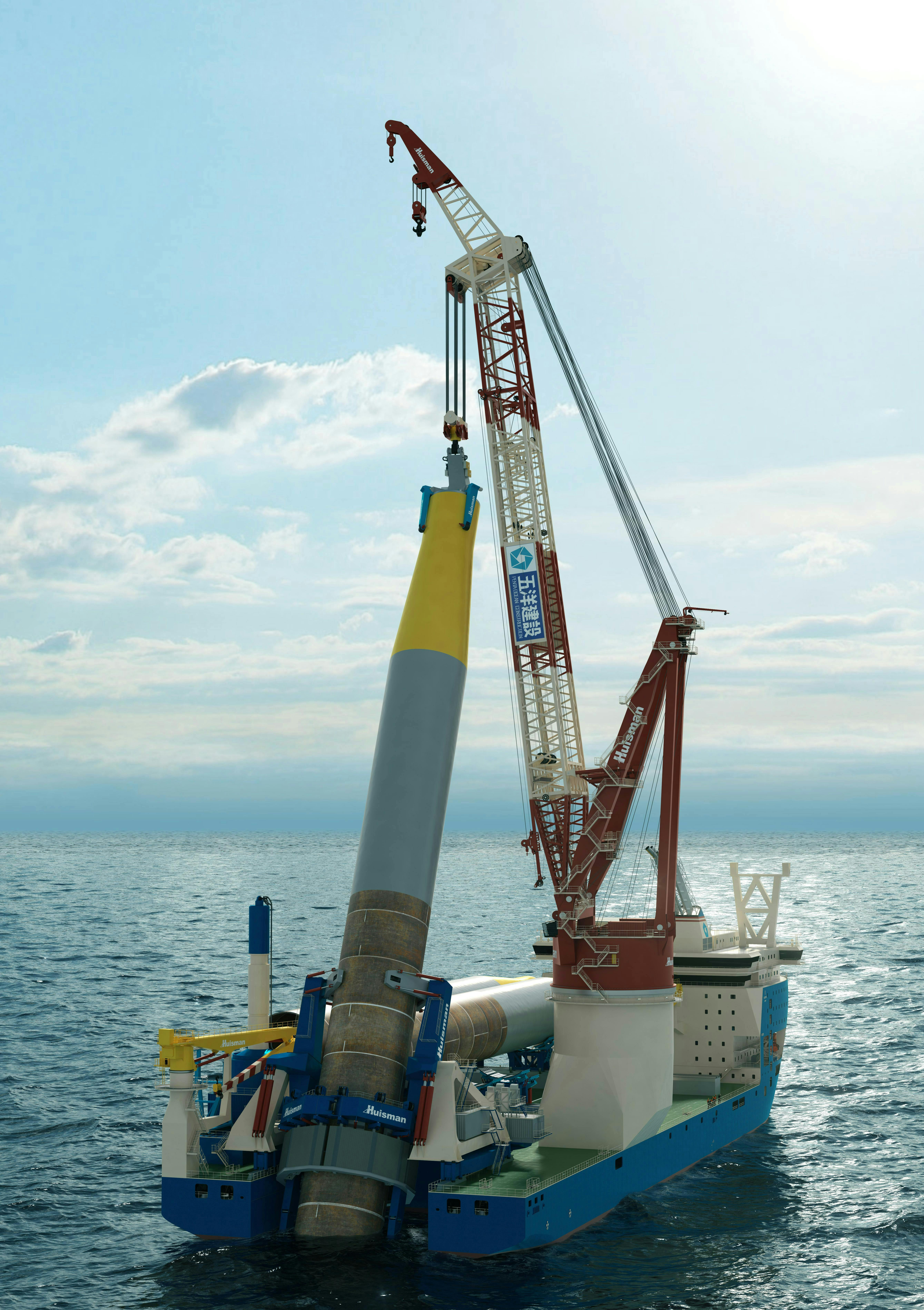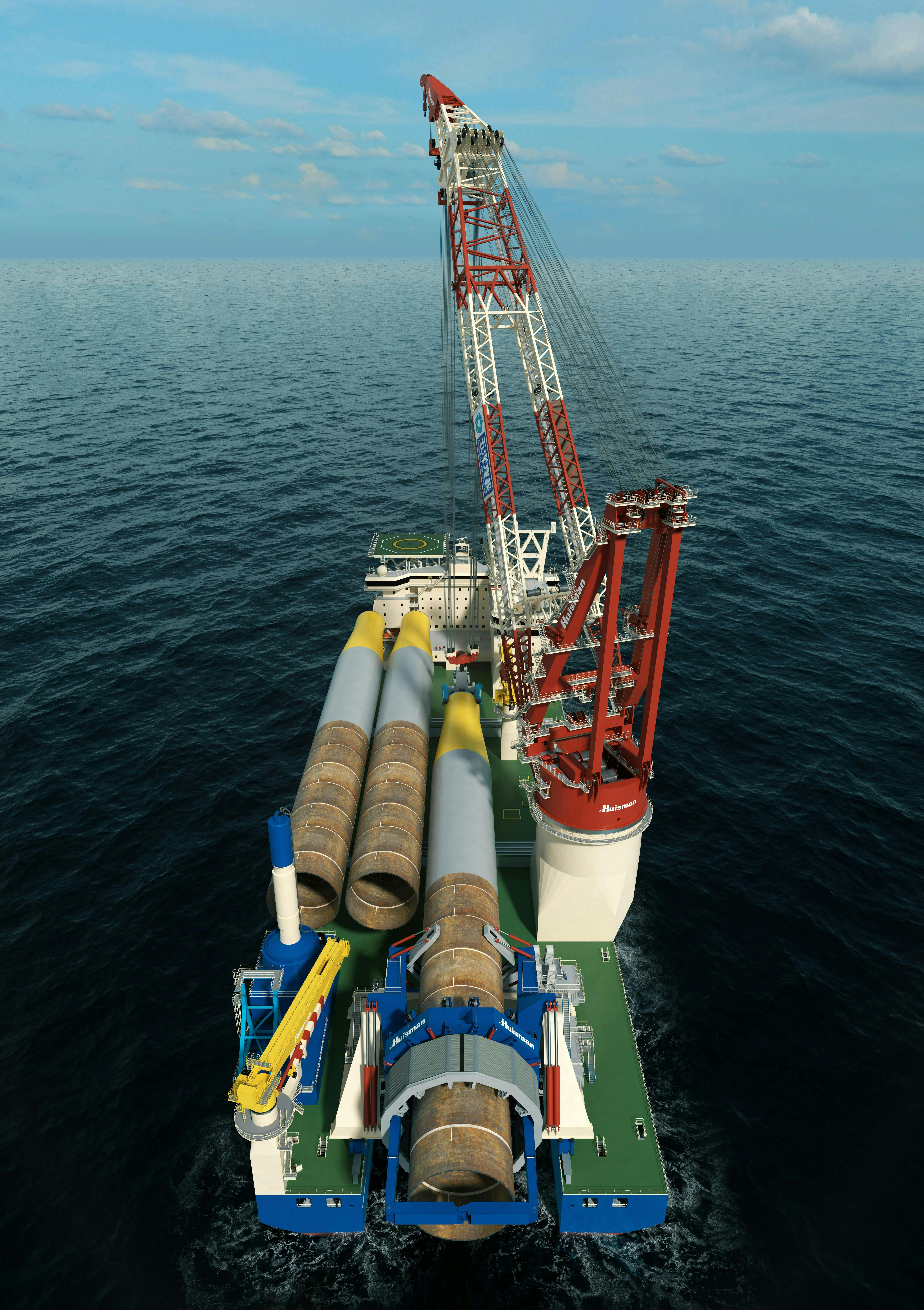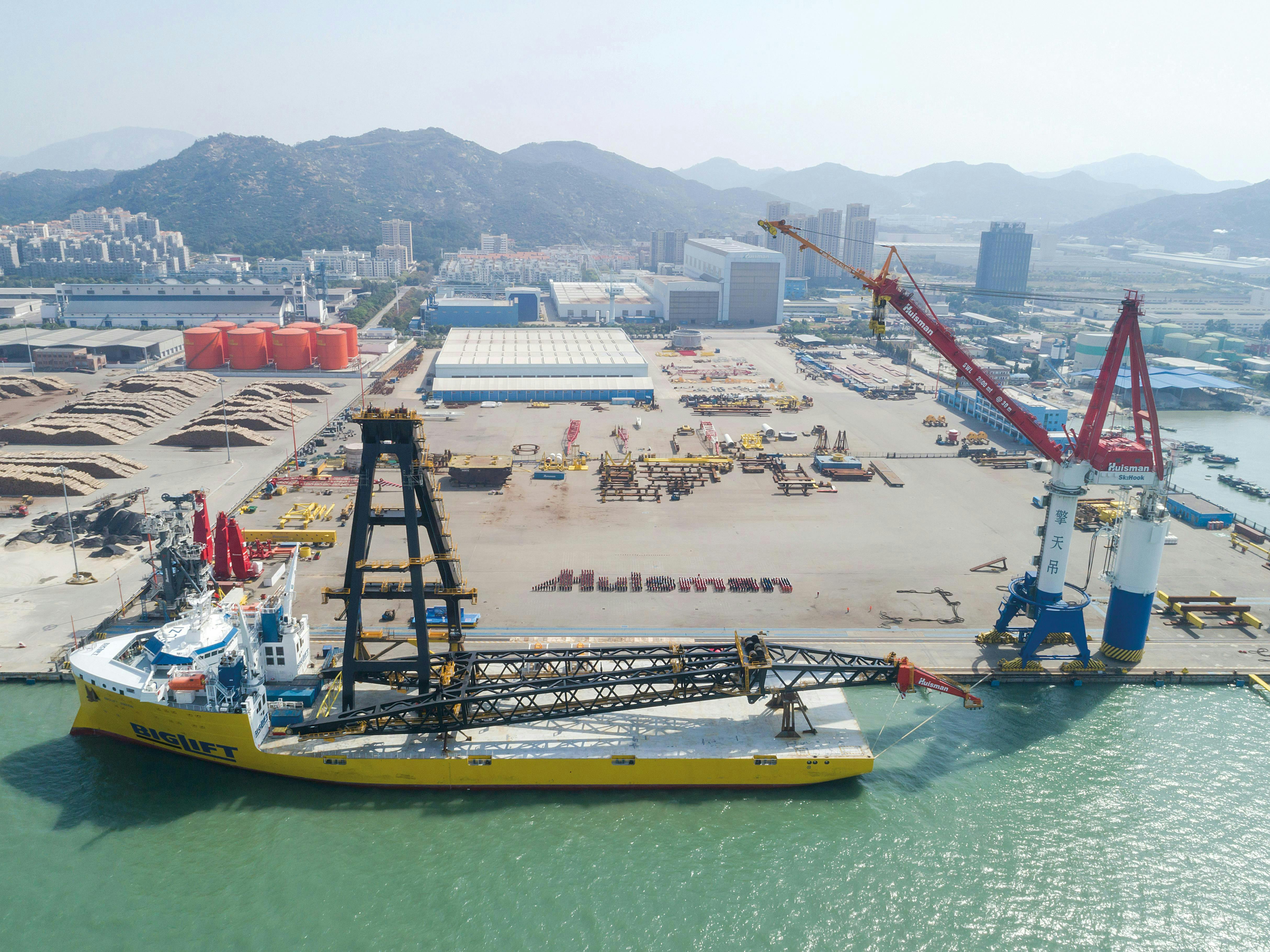Heavy-lift vessel will install next-generation monopiles offshore Japan
By Jeremy Beckman, Editor, Europe
Japan's first dedicated offshore wind construction vessel, designed to handle larger, next-generation monopile foundations, should be ready to start service by late 2028. Owner Penta-Ocean Construction will bid the ship, which is currently undergoing assembly at Seatrium in Singapore, for multiple planned offshore wind developments in the Sea of Japan off the country’s west coast.
The customized Ulstein HX118-design heavy-lift vessel is said to be the largest to date for the offshore wind sector anywhere and the longest featuring Ulstein’s streamlined X-BOW hull shape. It will be capable of installing different sizes of monopiles up to the largest supporting next-generation wind turbines. The vessel will collect monopiles from ports along the coast, transporting them longitudinally along the centerline of the deck for the voyage to the designated wind farm. Upon arrival at the individual turbine locations, each monopile foundation will be upended using a fully revolving, 5,000-metric ton crane and a gripper with upending capabilities, then lowered through a wave-shielded, U-shaped recess at the stern (known as the U-STERN) for connection to the seabed.
Ulstein Design & Solutions and Huisman jointly developed the vessel and its novel installation and lifting systems, in partnership with Penta-Ocean. The vessel will be owned jointly by a subsidiary of Penta-Ocean and Fuyo General Lease Co., with an estimated construction cost of about Y120 billion ($844 million). It is due to be delivered in May 2028.
“This is the first fully integrated heavy-lift vessel for offshore wind construction,” said Timon Ligterink, Huisman's commercial director, Asia-Pacific. “Normally with new vessel types, the equipment contracting processes follow standard procedures: the client will first develop the vessel with a ship designer, such as Ulstein, then determine what kind of crane can fit on such a vessel, and confirm that it matches requirements. Then the client sanctions building of the vessel and, at a much later moment, will consider the other lifting equipment onboard.
“The process we undertook with Penta-Ocean was quite the opposite. We started off with a monopile—what they wanted to lift, and then Huisman designed the crane with a certain geometry around it, while Ulstein designed a vessel that could lift and store these monopiles in a certain way. At the same time, Huisman undertook the process of designing all the handling equipment to install the monopiles.”
From the outset, added Ko Stroo, lead naval architect and project manager at Ulstein Design & Solutions in Rotterdam, “Penta-Ocean allowed us to work together. Normally clients like to be in control, separate all the contractors. But we were allowed to hold discussions on a weekly basis and jointly developed both the vessel and the equipment in parallel.”
Getting to final sign-off on the design followed over four years of collaborations with Penta-Ocean, including intensive back-and-forth discussions concerning the monopiles, studies and model tests. Huisman’s initial contact with the company came via a trade mission to Japan in 2015, when it was introduced to various Japanese groups interested in moving into offshore wind.
“Back then,” Ligterink recalled, “Penta-Ocean was contemplating building a dedicated vessel to install offshore wind turbines, even though the market in Japan at the time was non-existent…Some time afterwards, they came to us and explained that they wanted to build a vessel but didn’t know what size crane. We then spent another year or so in discussions on the exact configurations and sizes and so on, then ended up with the contract. Very contrary to Europe where you’re used to tendering all the way to the last terms and conditions, after which the shipyard or other stakeholder makes the decision which supplier is chosen.”
Ulstein was involved in the design tender for the vessel, proposing the U-STERN concept, which was selected after an extensive evaluation and concept development phase, followed by contract award in 2023.
“We did use the metocean data for Japan to develop the vessel’s motion characteristics and also the operability,” Stroo said, “but it’s not much different from North Sea conditions. Earthquakes have been discussed in hazards analysis, what to do, but didn’t result in direct, special design features.”
“This will be the sole heavy-lift vessel capable of installing the next-generation monopiles offshore Japan,” added Ligterink, “apart from the usual shearlegs with less workability. If you look at the geography of Japan, what primarily stands out is the diversity in conditions: on the western side, the Sea of Japan, typically shallow-water conditions, much like the North Sea, [and] on the eastern side, the Pacific Ocean characteristics with a much longer swell. With Japan being such an isolated market, Penta-Ocean wants to use the vessel on both sides. So the diversity in the specs and requirements of the vessel is quite big—and that’s why it is capable of working in different environments.
“Offshore wind development is starting offshore Japan’s northwest coast, and different projects are also planned on the eastern side. But there the water depths are generally much deeper and the shelf really drops steeply. So there are a limited number of locations where they can do bottom-fixed wind, which is what this vessel is for. Also, there aren’t a lot of areas with very similar soil conditions; there are rocks, sand, clay, you see everything there. And this vessel needs to cope with all of those conditions, both sides of Japan.”
Lengthwise placements
The 5,000-mt capacity, tub-mounted crane and monopile handling system were both developed collaboratively by Huisman, Penta-Ocean and Ulstein for integration onto the vessel. The active heave-compensated, fully revolving crane has a dual main hoist and Universal Quick Connector for swift tooling change-outs. Among its main design features are a compact tail swing to support deck space optimization and a Huisman-designed slew bearing. The motion-compensated pile gripper is engineered to assist the transfer of large-diameter monopiles of varying lengths over the U-STERN and into the water. With the lengthwise storage arrangement for the monopiles, the crane/gripper upending arrangement allows for direct pickup and handling from their storage position to installation.
“When designing this equipment,” Ligterink explained, “you must take a certain maximum and minimum monopile size into account. Clients are always very clear about the maximum, less so about the minimum, but it’s equally important. If you’re lifting a monopile, you need to upend it from a horizontal to vertical position, then lower it. But you also need to hold the monopile in multiple locations. So if you design your equipment to hold that monopile as far away from its center of gravity as possible, you are automatically bound by the dimensions of the smallest monopile. Or you need to be able to use the equipment in multiple configurations to also cater for shorter monopiles, which is what we have done with this vessel. And the lifting equipment is engineered to suit an enormously wide range of monopiles—bigger than anything Huisman has taken on before.”
The number of monopiles the vessel can transport and store lengthwise along the centerline of the deck depends on their size.
“For the largest, we are looking at three monopiles maximum that the vessel can carry at one time, so efficiency is super important," Stroo added. "The vessel needs to transit with the monopiles loaded onboard quickly and install them as efficiently as possible. On conventional installation vessels, monopiles are typically stored in a transverse direction, which theoretically allows more monopiles to be loaded. But then you run into the limitations of sailing conditions, with a 130-m [426-ft] monopile sticking out on both sides of the vessel for 40 or 50 m [131 or 193 ft]. A little bit of roll will cause them to touch the water. By having the monopiles in a longitudinal direction, they are comfortably secured on deck. This arrangement also enables maximized cycle times. The vessel has a bare minimum on handling of the monopiles, mostly because we can install them directly from the centerline in the U-STERN. That saves a lot of time for each monopile installation.”
As for collecting monopile consignments, there are at present only a limited number of ports available to support all the planned offshore wind developments in Japan.
“You need to load the monopile very close to the vessel in order to bring them onboard,” Ligterink said. “That in turn requires a very strong quayside to bring these heavy structures close to the vessel. The way we have developed the crane is with a very big overturn moment, bigger than for offshore wind vessels currently operating in Europe, for instance. That means you can lift the same 5,000-t load at a much larger distance from the centerline of the crane—and the requirements for the quayside and bearing capacity in the harbor are therefore much lower.”
Stroo added, “We also developed the vessel to support that overturning moment while doing so with a minimum operating draft; that’s because many of Japan’s ports are not very deep. So the ship needs to be capable of loading in harbor in not ideal draft conditions, and you need a strong cooperation to make that happen.”
Huisman first started working in Japan in 2016, initially developing cranes for two Penta-Ocean jackup vessels. It has since contracted a subsea crane to Toyo Construction for a cable-lay vessel and another crane to TOA & Obayashi for a jackup vessel. But this is its largest project both in Japan or anywhere in recent years, Ligterink said. Over the past 10 years, Ulstein has built a track record in Japan too, performing design work for various companies. However, this is also the company’s biggest job in the country to date.
“Offshore wind is a challenging market, with a lot of concepts being promoted by various vessel designers,” Stroo said. “Most of them, however, are not designed for the full installation cycle but only for a small part—not a holistic approach. The U-STERN is a totally new concept. We started working on it to see how we could install next-generation monopiles that are too large to transport transversely on a vessel. The idea originated from Ulstein’s long experience in developing heavy-lift pipelay vessels with a firing line in the middle, the goal being to install monopiles in a similar way.”
Ulstein ran an extensive comparison study when developing the U-STERN concept between transporting monopiles transversely and then installing them at the side of the vessel versus longitudinal transport followed by installation in the U-STERN.
“We also did a comparison between vessels using different installation methods—one on the side, one aft in the U-STERN—which revealed differences in motions and between DP power use," Stroo said. "When you install a monopile, you’re trying to find a shielding area away from the waves. So you’re looking to move your vessel in between the incoming waves and the monopile. A conventional monopile installation vessel with a gripper on the side requires a lot of DP power for the whole vessel to act as a wave breaker in front of the monopile. Performing the installation on the side of the vessel also results in far more vessel motions because of all the waves breaking on the vessel while it is stationed at 30° to achieve wave shielding.
“With the U-STERN, the vessel is around the monopile, providing very good shielding from the waves. And power consumption is much lower when you can nicely weathervane, as is the case with this design. It’s the same philosophy as turret mooring; the vessel can automatically select a heading, which minimizes the amount of resistance on wind and waves. Station-keeping/power is supplied via a DP2 system with thrusters, four Voith Schneider propellers in the aft and three tunnel, [and] two retractable thrusters in the front. And there is no problem with wave splashing in the U-STERN, similar to conditions in a moonpool aft ship."
He continued, “But while the reduced motions help, there are also quite a few critical points when performing a monopile installation. One is connecting the flange lifting tool to the top of the monopile when you start the upending process. With this concept, you can do that in the middle of the vessel inboard; when the MPs are stored transversely, you have to do that outboard, in a very difficult position. What’s also unique, on a conceptual level, is that with this installation method you don’t have any free-hanging loads during the entire installation cycle. So the monopiles are skidded directly from their storage position into the gripper, then upended. All other concepts always require free-hanging while offshore. Ours eliminates a lot of the safety risks, leading to significantly better cycle times and improved safety onboard.”
Ulstein had commissioned an extensive R&D program and tests for its U-STERN concept prior to starting work with Penta-Ocean, mostly computational fluid dynamics simulations of vessel motions and behavior in waves. For this project, MARIN (Maritime Research Institute Netherlands) performed model tests to validate the U-STERN’s shielding capability and the vessel’s motion characteristics. Hamburg maritime institute HSVA in Germany conducted further tests, mostly related to speed and power. PEUTZ conducted the wind tunnel tests for wind and current load prediction and smoke visualization. The tests showed that it was possible to point directly into the waves with the vessel and provided the necessary shielding with 50% less DP power, which suggests that much less fuel and energy are likely to be consumed.
“The tests also confirmed a 20% improvement in motions as you don’t have the roll of a conventional monopile installation vessel and its sideways movements,” Stroo said. “It’s a much more natural position for the ship to be positioned directly into the oncoming wave. Huisman also used the results of the tests to calculate its mission equipment requirements for the anticipated currents.”
Lifting arrangements
Ligterink noted, “Normally we are asked to design a crane for a vessel, and then the crane is delivered. And during construction of the crane, or even after it has been delivered, we are asked to retrofit a gripper or a monopile handling system to the vessel, which means you’re bound to the frontiers that are already out there: the maximum size of the vessel, the crane load curve, the capacity of the crane, but also the clearance between the boom, for instance, and the monopile when you’re upending it. If your handling system is very close to your own crane, you don’t want the monopile swaying towards the crane and potentially hitting it. So that boom clearance between what you’re lifting and the boom itself is very important. With Penta-Ocean, we were allowed to design all the elements of the lifting/handling equipment concurrently. So we could do all the checks and optimize the efficiency of the crane, motion-compensated gripper, storage and transport system to work together optimally with the other components.
“When designing large offshore cranes, the center of gravity is very important, not just for the crane’s size but also because it has to be installed on one side of the vessel. All the weight the crane adds to that side of the vessel needs to be accounted for as well on the other side in order to maintain an even keel. We try to design the crane with these parameters in a way that limits its weight, without compromising safety. Extensive finite element analysis is one way of doing this, along with Huisman’s in-house developed slew bearing. Essentially, this provides a way of transmitting the forces from the rotating part of the crane towards the solid steel structure underneath (the foundation of the crane). Traditionally that has been achieved via a bogie system with large diameter wheels."
He continued, "In the past, large offshore cranes were equipped with bogie slewing systems. This introduced the forces in concentrated points that could vary by slewing the crane, hence providing a very heavy and fatigue sensitive structure. Huisman newer-generation cranes come with large-diameter slew bearings that are tailored for use in large offshore cranes. This leads to better load distribution and higher reliability, at the same time reducing the crane's own weight significantly."
Huisman’s factory in Fujian Province, China, is constructing the crane and gripper system, supported by the company’s engineering and production offices in the Netherlands and Czech Republic. Ulstein’s responsibilities include supporting Penta-Ocean's site team at the Seatrium shipyard during construction of the vessel, “transferring our design knowledge to the shipyard so they can build the vessel as intended and to ensure adherence to the design and specifications,” Stroo said.
While monopile installations are the vessel’s primary purpose, it is also designed to perform more general heavy lifts of offshore wind jackets or substations.
“It’s the largest, most capable and first fully integrated heavy-lift vessel in the offshore wind industry, and that’s the main novelty,” Ligterink suggested. “Also, the versatility, being able to handle the largest and smallest monopiles, that’s unique. Especially with the storage cradles and systems onboard needed to handle monopiles. In the past, these would have been temporary steelworks, project-specific at best, sometimes not even reused—just cribbings to hold the monopiles in place, like heavy-lift transportation in the offshore oil and gas industry. But now, the number of monopiles to be transported is so big and the requirements so strict for protecting paint and surfaces, you need a very careful handling system to handle the monopiles, even more so in severe weather conditions. And that’s why contractors today are looking more at an integrated system to hold and transport monopiles that can operate throughout the life of the vessel.”
About the Author
Jeremy Beckman
Editor, Europe
Jeremy Beckman has been Editor Europe, Offshore since 1992. Prior to joining Offshore he was a freelance journalist for eight years, working for a variety of electronics, computing and scientific journals in the UK. He regularly writes news columns on trends and events both in the NW Europe offshore region and globally. He also writes features on developments and technology in exploration and production.




